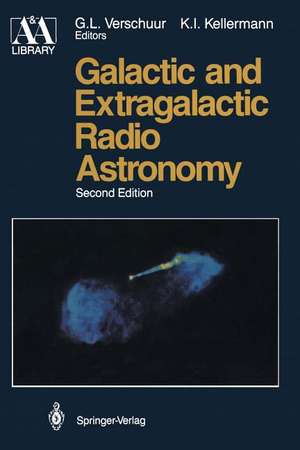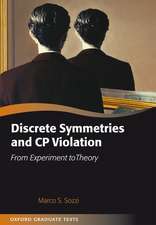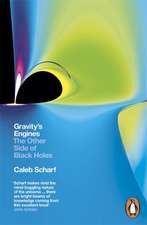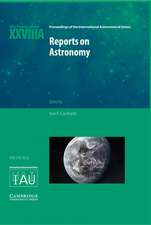Galactic and Extragalactic Radio Astronomy: Astronomy and Astrophysics Library
E. Bouton Editat de Gerrit L. Verschuur, Kenneth I. Kellermannen Limba Engleză Paperback – 20 dec 1991
Din seria Astronomy and Astrophysics Library
- 17%
 Preț: 496.37 lei
Preț: 496.37 lei - 15%
 Preț: 603.58 lei
Preț: 603.58 lei - 19%
 Preț: 455.24 lei
Preț: 455.24 lei - 17%
 Preț: 525.72 lei
Preț: 525.72 lei - 13%
 Preț: 393.37 lei
Preț: 393.37 lei - 19%
 Preț: 524.14 lei
Preț: 524.14 lei - 17%
 Preț: 393.90 lei
Preț: 393.90 lei - 15%
 Preț: 647.40 lei
Preț: 647.40 lei - 15%
 Preț: 541.54 lei
Preț: 541.54 lei - 17%
 Preț: 362.70 lei
Preț: 362.70 lei - 18%
 Preț: 1006.55 lei
Preț: 1006.55 lei - 18%
 Preț: 745.33 lei
Preț: 745.33 lei - 15%
 Preț: 641.20 lei
Preț: 641.20 lei -
 Preț: 397.38 lei
Preț: 397.38 lei - 15%
 Preț: 598.21 lei
Preț: 598.21 lei - 15%
 Preț: 658.05 lei
Preț: 658.05 lei - 23%
 Preț: 815.07 lei
Preț: 815.07 lei -
 Preț: 409.89 lei
Preț: 409.89 lei - 15%
 Preț: 610.61 lei
Preț: 610.61 lei -
 Preț: 393.90 lei
Preț: 393.90 lei - 15%
 Preț: 655.27 lei
Preț: 655.27 lei - 18%
 Preț: 951.47 lei
Preț: 951.47 lei - 18%
 Preț: 960.42 lei
Preț: 960.42 lei - 18%
 Preț: 1397.68 lei
Preț: 1397.68 lei - 18%
 Preț: 959.98 lei
Preț: 959.98 lei - 18%
 Preț: 1012.08 lei
Preț: 1012.08 lei - 15%
 Preț: 481.03 lei
Preț: 481.03 lei - 15%
 Preț: 672.43 lei
Preț: 672.43 lei -
 Preț: 413.15 lei
Preț: 413.15 lei - 18%
 Preț: 1554.72 lei
Preț: 1554.72 lei - 18%
 Preț: 1410.63 lei
Preț: 1410.63 lei -
 Preț: 390.08 lei
Preț: 390.08 lei - 18%
 Preț: 944.99 lei
Preț: 944.99 lei - 19%
 Preț: 502.94 lei
Preț: 502.94 lei - 15%
 Preț: 654.12 lei
Preț: 654.12 lei - 24%
 Preț: 851.62 lei
Preț: 851.62 lei - 19%
 Preț: 515.32 lei
Preț: 515.32 lei - 15%
 Preț: 663.14 lei
Preț: 663.14 lei - 15%
 Preț: 656.43 lei
Preț: 656.43 lei - 18%
 Preț: 741.68 lei
Preț: 741.68 lei - 15%
 Preț: 647.40 lei
Preț: 647.40 lei -
 Preț: 388.90 lei
Preț: 388.90 lei - 18%
 Preț: 1223.11 lei
Preț: 1223.11 lei - 15%
 Preț: 651.51 lei
Preț: 651.51 lei - 15%
 Preț: 655.27 lei
Preț: 655.27 lei -
 Preț: 347.59 lei
Preț: 347.59 lei - 18%
 Preț: 794.39 lei
Preț: 794.39 lei
Preț: 548.10 lei
Preț vechi: 644.83 lei
-15% Nou
Puncte Express: 822
Preț estimativ în valută:
104.88€ • 109.78$ • 87.29£
104.88€ • 109.78$ • 87.29£
Carte tipărită la comandă
Livrare economică 01-15 aprilie
Preluare comenzi: 021 569.72.76
Specificații
ISBN-13: 9780387977355
ISBN-10: 038797735X
Pagini: 694
Ilustrații: XXII, 694 p.
Dimensiuni: 155 x 235 x 37 mm
Greutate: 0.99 kg
Ediția:Softcover reprint of the original 2nd ed. 1988
Editura: Springer
Colecția Springer
Seria Astronomy and Astrophysics Library
Locul publicării:New York, NY, United States
ISBN-10: 038797735X
Pagini: 694
Ilustrații: XXII, 694 p.
Dimensiuni: 155 x 235 x 37 mm
Greutate: 0.99 kg
Ediția:Softcover reprint of the original 2nd ed. 1988
Editura: Springer
Colecția Springer
Seria Astronomy and Astrophysics Library
Locul publicării:New York, NY, United States
Public țintă
GraduateCuprins
1. Galactic Nonthermal Continuum Emission.- 1.1 Introduction.- 1.2 Physical Processes.- 1.3 Total Intensity Observations of the Galactic Radio Continuum.- 1.4 The Spectrum of the Nonthermal Emission.- 1.5 Linear Polarization of the Nonthermal Emission.- 1.6 The Galactic Nonthermal Radiation in Perspective.- Recommended Reading.- References.- 2. HII Regions and Radio Recombination Lines.- 2.1 Ionized Interstellar Hydrogen.- 2.2 Radiation Transfer.- 2.3 Continuum Thermal Emission (Bremsstrahlung).- 2.4 Basic Theory of Radio Recombination Lines.- 2.5 Refinements to the Transfer Equations.- 2.6 Single-Dish Observations of Radio Recombination Lines from HII Regions.- 2.7 Exploration of the Milky Way by Radio Recombination Lines.- 2.8 Radio Observations of HII Regions with High Angular Resolution.- 2.9 Other Aspects of Radio Recombination Lines.- 2.9.1 Low Frequencies.- 2.9.2 Zeeman Effect.- 2.9.3 The Sun.- 2.9.4 Planetary Nebulae.- 2.9.5 Dark Clouds.- 2.9.6 Galaxies and Quasars.- Recommended Reading.- References.- 3. Neutral Hydrogen and the Diffuse Interstellar Medium.- 3.1 Introduction: Fundamentals.- 3.2 Structure of the Diffuse Interstellar Medium: HI Emission.- 3.3 Temperature and Ionization of the Diffuse Interstellar Medium.- 3.4 Interstellar Magnetic Fields.- 3.5 Summary.- Recommended Reading.- References.- 4. Molecules as Probes of the Interstellar Medium MID of Star Formation.- 4.1 Introduction.- 4.2 The Large-Scale Morphology of the ISM.- 4.3.1 Small Star-Forming Cores in SMCs and GMCs.- 4.4 The Stability of Molecular Clouds and Cores.- 4.5 The Formation of Stars.- 4.6 Future Prospects.- Recommended Reading.- References.- 5. Interstellar Molecules and Astrochemistry.- 5.1 Molecules in Space: An Overview.- 5.2 Where Molecules Are Found: Basic Morphology of the Dense Interstellar Medium.- 5.3 Molecular Abundances and Their Determination.- 5.4 The Four Basic Schemes of Interstellar Chemistry.- 5.5 Current Dilemmas and Future Directions.- Recommended Reading.- References.- 6. Astronomical Masers.- 6.1 Introduction.- 6.2 Maser Theory.- 6.3 Interstellar Masers.- 6.4 Stellar Masers.- 6.5 Extragalactic Masers.- 6.6 Interstellar Scattering.- 6.7 Distance Measurements.- Recommended Reading.- References.- 7. The Structure of Our Galaxy Derived from Observations of Neutral Hydrogen.- 7.1 Observations of Galactic Neutral Hydrogen.- 7.2 Kinematics of Galactic Neutral Hydrogen.- 7.3 Mapping the Galaxy Using Neutral Hydrogen Observations.- 7.4 The Inner-Galaxy Gas Layer.- Recommended Reading.- References.- 8. The Galactic Center.- 8.1 Introduction and Apologia.- 8.2 Radio Continuum Emission from the Provinces of Sagittarius.- 8.3 Sgr A and Its Immediate Environment.- 8.4 Material in Sgr A Observed on 10- to 50-pc Scales.- 8.5 The Neutral Gas Reservoir in the Inner Galactic Regions.- Recommended Reading.- References.- 9. Radio Stars.- 9.1 The Early Years.- 9.2 Fundamental Radio Emission Processes and Stellar Radiative Transfer.- 9.3 Solar Radio Emission.- 9.4 Flare Stars and Active Binaries.- 9.5 Stellar Winds.- 9.6 Cataclysmic Variables.- 9.7 Radio-Emitting X-Ray Binaries.- 9.8 Future Work on Radio Stars.- Recommended Reading.- References.- 10. Supernova Remnants.- 10.1 Introduction.- 10.2 Supernovae.- 10.3 Observed Properties of Supernova Remnants.- 10.4 Theory.- 10.5 Collective Interactions of Supernova Remnants with the Galaxy.- 10.6 Future Prospects.- Recommended Reading.- Catalogues of Galactic Supernova Remnants.- References.- 11. Pulsars.- 11.1 Introduction.- 11.2 Basic Properties.- 11.3 Pulse Morphology and Polarization.- 11.4 IntensityFluctuations.- 11.5 Interstellar Propagation.- 11.6 Timing and Astrometry.- 11.7 Binary and Millisecond Pulsars.- 11.8 Radio Emission Mechanism.- Recommended Reading.- References.- 12. Extragalactic Neutral Hydrogen.- 12.1 Introduction.- 12.2 The Distribution of HI in Galaxies.- 12.3 Velocity Fields.- 12.4 The Velocity Width as a Distance Indicator.- 12.5 HI Content and Other Global Properties.- 12.6 Environmental Effects.- 12.7 Cosmological Studies.- Recommended Reading.- References.- 13. Radio Galaxies and Quasars.- 13.1 Introduction.- 13.2 Low-Luminosity Sources.- 13.3 Compact Sources.- 13.4 Extended Sources.- 13.5 Summary.- Recommended Reading.- References.- 14. The Microwave Background Radiation.- 14.1 Introduction.- 14.2 The Spectrum of the Microwave Background.- 14.3 Polarization of the Microwave Background.- 14.4 Anisotropy Searches.- 14.5 The Sunyaev-Zel’dovich Effect.- Recommended Reading.- References.- 15. Radio Sources and Cosmology.- 15.1 Introduction.- 15.2 Basic Relations.- 15.3 The “World Picture” and Source Evolution.- 15.4 Source Population Data.- 15.5 Evolutionary Models.- 15.6 Source Size Evolution.- 15.7 The Faint-Source Population.- 15.8 Isotropy and Homogeneity.- 15.9 Cosmology Made Simple: The Shell Model.- 15.10 What Next?.- Recommended Reading.- References.














